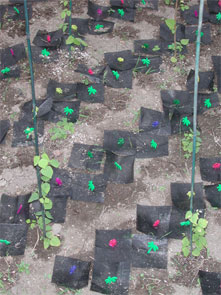Evolution of maternal effects in plants
Widespread seedling mortality and early establishment of competitive hierarchies make an understanding of the factors that contribute to seedling success critical to predicting plant fitness.
Many of the characters that determine seedling success, including dispersal, dormancy and seed size, are largely under the control of the maternal plant, and thus maternal effects may contribute strongly to plant population dynamics. I have studied the potential evolutionary impacts of maternal effects from ecological, physiological and evolutionary genetic perspectives.
Maternal plants can potentially influence the environment that their offspring experience by altering characteristics of seed dispersal and dormancy. Mothers may also influence the success of their offspring in different environments by changing the amount or composition of resources in the seed. For my doctoral dissertation, I explored the effects of environmental variation on patterns of seed dispersal, seed provisioning and offspring fitness in Amphicarpaea bracteata. A. bracteata is an annual twining legume that produces two different seed types: small balistically-dispersed aerial seeds and subterranean seeds that are borne on geotropic runners. A multi-year survey of four natural populations revealed that moisture and light availability were significantly auto-correlated over the dispersal distance of the subterranean seed type but were less or not predictable over the longer dispersal distance of the aerial seeds.  Predictability of subterranean seedling environment coupled with variation in environment among maternal individuals provides the opportunity for selection on adaptive plasticity of subterranean seed provisioning. That is, maternal plants would benefit from adjusting provisioning of subterranean seeds in response to their own (maternal) environment such that subterranean seedlings are supplied with resources appropriate to an environment similar to that of the mother. Predictability of subterranean seedling environment coupled with variation in environment among maternal individuals provides the opportunity for selection on adaptive plasticity of subterranean seed provisioning. That is, maternal plants would benefit from adjusting provisioning of subterranean seeds in response to their own (maternal) environment such that subterranean seedlings are supplied with resources appropriate to an environment similar to that of the mother.
Using patch choice experiments, however, I determined that the subterranean-seed-bearing runners of A. bracteata forage between microsites and that subterranean seeds are preferentially placed in moist, dark locations. This directed dispersal of subterranean seeds suggests selection on maternal provisioning strategy to optimize seedling performance in darker, wetter conditions rather than the plastic provisioning to match maternal environment. 
In greenhouse experiments, I showed that selection for increased seed size was stronger in deeper shade. Plants grown under shaded conditions produced a much higher ratio of the massive subterranean seeds compared to the smaller aerial seeds, and the aerial seeds that were produced in shade were larger. Taken together, these results suggest that maternal individuals of A. bracteata increase progeny fitness in shade both by increasing the size of the aerial seed type as by increasing the relative production of the more massive of subterranean seeds. Maternal fitness is also impacted by the production of subterranean vs. aerial seeds, however, as the production of a subterranean seed consumes many more maternal resources than aerial seed production and will reduce the total number of progeny that can be produced (manuscript in prep for American Naturalist, available on request).
In a set of multigenerational experiments, collaborators and I found that maternal plants grown under elevated UV-B produced seed coats (which are maternally-derived) that were much richer in UV-absorbing compounds such as flavonoids that provide protection against UV damage, thus suggesting a physiological mechanism of adaptive maternal plasticity (doi: 10.1111/j.1469-8137.2004.01013.x ).
My research into the evolution of maternal effects in plants has demonstrated that maternal plants respond to their own environment by altering the provisioning of offspring in ways that may be adaptive. In future research, I plan to use multi-generational experiments to test whether A. bracteata exhibits adaptation of subterranean seeds specifically to preferred microsite types or whether maternal plants plastically and adaptively alter provisioning of subterranean seeds in response to their own (maternal) environment. Employing evolutionary models, I will continue to explore how plasticity of maternal provisioning affects fitness of both mothers and offspring, and to study further how these maternal effects contribute to plant population dynamics.
Home Page |
Site Map |
Contact information
|